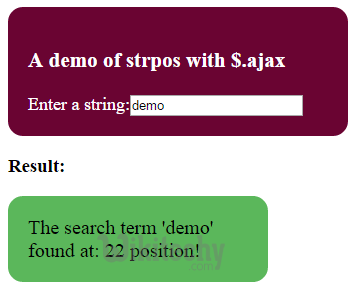

$.ajax method map object series#
The Choropleth Map is used in this sample, as it is one of the most popular series type. When the data is defined, it's time to create series.ĪnyMap provides several types of series, so at the first step make up your mind about which series (map) type (or types) is going to be used in the Drill Down Map. In the next sample we've set the data as array of objects. In the sample, the data about population in 2000 was used.Īs usual, the data can be defined as array of arrays or as array of objects. Let's create a data set for the current map of the USA and for maps of Florida and Texas, which will be loaded later using the Data Adapter. The following sections and examples are describing and demonstrating working with the An圜hart Data Adapter. To create a sample with maps being added through AJAX request, include an AJAX component to the Drill Down Map sample (in the same section):

If necessary, it is possible to use any other library, e.g., jQuery though, the Data Adapter is functional enough. This article describes using the special An圜hart Data Adapter.
$.ajax method map object how to#
There are a lot of ways how to add the maps into the charts. It is better to add the root map the same way: Īny other An圜hart components can be included separately the same way as AnyMap, but it's better to include, which can be found on the same download page. Reference the AnyMap JavaScript file in the section of your web page. All jQuery AJAX methods use the ajax () method.


It’ a simple HTTP GET method in the background which fetches some HTML from server and insert it into element’s DOM. JQuery load() function loads some HTML via AJAX and inserts it into the selected element. The syntax for using this function is: $.ajax( This function is used to perform HTTP requests which are by default asynchronous. In the root of jQuery Ajax is ajax() function. Asynchronous Communication jQuery Ajax Global Event Handlers $.ajaxSend() $.ajaxStart() $.ajaxStop() $.ajaxSuccess() $.aja圎rror() $.ajaxComplete() Using $.ajaxSetup() to Globalize Parameters Using $.ajaxPrefilter() to filter Ajax Requests Other Ajax Powered Functions in jQuery $.get() and $.post() Functions $.load() Function $.getScript() XHR (XMLHttpRequest) Invoking jQuery Ajax HTTP Methods Synchronous vs. $.ajax() Method jqXHR (jQuery XMLHttpRequest) vs.
$.ajax method map object full#
Learn to utilize the full power of AJAX with jQuery to make application development easy, fast as well as effective.


 0 kommentar(er)
0 kommentar(er)
